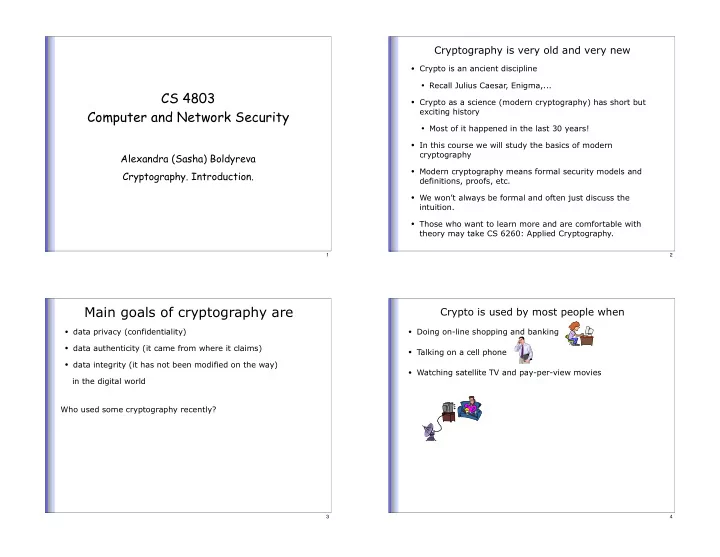

Cryptography is very old and very new • Crypto is an ancient discipline • Recall Julius Caesar, Enigma,... CS 4803 • Crypto as a science (modern cryptography) has short but Computer and Network Security exciting history • Most of it happened in the last 30 years! • In this course we will study the basics of modern cryptography Alexandra (Sasha) Boldyreva • Modern cryptography means formal security models and Cryptography. Introduction. definitions, proofs, etc. • We won’t always be formal and often just discuss the intuition. • Those who want to learn more and are comfortable with theory may take CS 6260: Applied Cryptography. 1 2 Main goals of cryptography are Crypto is used by most people when • data privacy (confidentiality) • Doing on-line shopping and banking • data authenticity (it came from where it claims) • Talking on a cell phone • data integrity (it has not been modified on the way) • Watching satellite TV and pay-per-view movies in the digital world Who used some cryptography recently? 3 4
Players and settings Players and settings ... ... pkr R pkr ... ... A A pkr K K skr R S R S 1. Symmetric-key setting 2. Asymmetric (public)-key setting 5 6 Goals and primitives Symmetric vs public-key crypto • Symmetric schemes are easier to construct and implement (less math is required) setting • Symmetric schemes are faster (by 3-4 orders of magnitude) symmetric-key asymmetric-key goal • But how do parties agree on the shared key at the first place? symmetric (secret-key) asymmetric (public- data privacy encryption key) encryption message data authenticity/ digital signature authentication code integrity scheme (MAC) 7 8
How good is a scheme? Symmetric encryption schemes • “Trial-and-error” approach: • A scheme SE is specified by 3 algorithms K,E,D . 1. Try to find an attack MsgSp-message space 2. If an attack found then the scheme is insecure, fix the scheme, K KeySp-key space � repeat step 1. SE = � K,E,D � or 3. If no attack found then ....? SE = � KeySp ,E,D � • “Provable security” approach: A K K • show that if an attack found (a scheme is insecure), then one can break some trusted assumption (e.g. factoring) C C M � � M • requires a definition of what “secure” means S R It is required that for every M ∈ MsgSp and every K ∈ KeySp, D ( K, E ( K, M))=M 9 10 One Time Pad Perfect (Shannon) security • OneTimePad=( K,E,D ), MsgSp={0,1}n: • Def (informal). An encryption scheme SE=(K,E,D) is perfectly secure if everything what can be learned about the message from a ciphertext can be learned without the • � : return a random n-bit string K (KeySp={0,1}n) ciphertext. • � (K,M): C � M ⊕ K , return C • Th.1 OneTimePad is a Shannon-secure encryption scheme. • � (K,C): M � C ⊕ K , return M • Th.2 [Shannon’s theorem, optimality of OneTimePad] • Example: M= 011111111011101 If a scheme is perfectly secure, then the key space cannot K= 110010011010100 be smaller than the message space (if KeySp={0,1}k and C= 101101100001001 MsgSp={0,1}m, then k � m and a key must be as long as • As the name suggests, the scheme is to be used only once: a the message we want to encrypt). new key must be used to encrypt a new message. 11 12
• So we cannot do better than OneTimePad. But it is impractical (very fast, but we need a very long key). Is it the end? Yes, of the information-theoretic (unconditionally secure) crypto. No, if we relax the security requirement and assume that adversaries are computationally bounded. We will also assume that • Bad guys have limited computational power • There are some “hard” problems • Secret keys are secret • But we will NOT assume that algorithms are secret. All algorithms are public (Kerckhoff’s principle). “Security by obscurity” is a bad idea! • We move to the area of computational-complexity crypto, that opens a lot of possibilities. 13
Recommend
More recommend